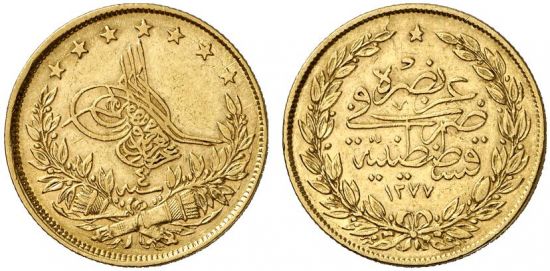Turkey AH1277(4) 100 kurush
The Ottoman empire formed in the 1300’s and went through several centuries of expansion to the east and west. By the 1700’s Ottoman political and military power was waning, despite the large geographical extent of its possessions. By the mid-1800’s, several possessions such as Egypt and Tunisia had already sought degrees of autonomy or were occupied by European forces. The Ottoman Empire came officially to and end after World War I, paving the way for a much smaller and politically modern Republic of Turkey.
This specimen was lot 219 on Dec 13, 2011 at the Kunker Auction #199 in Osnabruck, Germany, where it sold for 320 euros. The catalog description reads:
"OSMANISCHE MÜNZEN 'ABD AL-'AZÎZ KHAN (TÜRKEI-TÜRKISCH: ABDÜLAZIZ HAN)) 15. DHÛ I-HIJJA 1277 - 5. JUMÂDÂ II 1293 H. 25. JUNI 1861 - 30. MAI 1876, GESTORBEN 5. JUNI 1876 Goldprägungen der Münzstätte Qustantînîya 100 Kurush 1277 H., 4, Qustantînîya. GOLD. Vorzüglich. (Ottoman Empire, Abdul Aziz, 1861-76, gold hundred kurush of AH 1277, year 4, extremely fine)"
Recorded mintage:. 628,000.
Specifications:. 7.216g, 0.9170 gold, 0.2128 oz AGW.
Catalog reference: KM 696; Ölcer 32.034; Pere 918, this specimen 7.13 g.
- Michael, Thomas, and Tracy L. Schmidt, Standard Catalog of World Coins, 1801-1900, 9th ed., Iola, WI: Krause Publications, 2019.
- Uslu, Kaan, Beyazit, M. Fatih, and Kara, Tuncay. Ottoman Empire Coins, Istanbul: Mas Matbaacilik A.S., 2007.
Link to:
